#‹ * ﹕ a brutally soft woman . / modern ii . ›
Explore tagged Tumblr posts
Text
time to shine tag
i was tagged by @sheimagineddragons tysm kit!! <3
Only rule: Be as thirsty for attention as you want to be! Link one of your old fics/art pieces or one that didn’t get enough attention, link a work you loved to create or share a draft from your newest WIP. Or do all of these. Be greedy. Show your art. Crave attention. Be proud. And don’t forget to give your friends an excuse to show off theirs!
Additional note: Please consider dropping one of your favorite hidden gems by an other author along with your own work so others can enjoy it as well and so that it doesn’t stay buried any longer!
a little bit of you & a little bit of me okay i'm starting with this fic i wrote for atla gen week about jinora & her relationship with being an eldest sister. when i started writing, i was well aware it wouldn't get a lot of attention between being a gen fic, being a tlok fic, being centered on a non-main character, and the fact that it is. um. 19k words,, but i'm still really proud of how it turned out and it's a fic that's very personal to me bc it's a lot of self projection + lowkey it was my way of coming to terms with being nonbinary lol
never been in love (and it's all good) next is yet another fic i wrote for gen week, this time centered on aro bumi ii. it's a 5+1 fic and has a lot of bumi ii & family moments
only if you want to this is yet another tlok fic, this one centered on kya ii and her dealing with sleep-related issues. it's got a lot of kya & bumi and kya & lin in it!!
of all the stars, the fairest finally i am going to promote the fic i wrote for the atla 18+ big bang, which is a mailee fake dating fic, simply bc wlw fics never get as many reads and oatstf is my baby
okay as for other people's fics, i have. so many i could rec but i will try to keep it (semi) short
a friend is still a friend by @that-was-anticlimactic is a fic about jet & sokka being frenemies and it's just. literally so perfect. it made me feel such a wide range of emotions and i absolutely adore it. (also if you liked the jet & sokka dynamic in my enby sokka fic, you will love their dynamic in this as well)
the tell me what you want me to say series by @zukoisgayforsokka it's vv cute and has zukka, yueki, and background mailee & jinzula and i love it so much!!
a brutally soft woman by @rolandtowen which is about nonbinary suki and i love love love it!!
i like my girls just like i like my honey by clumsycrow is a yueki meet cute one shot with best friends yue & sokka and suki running a booth at a local farmer's market and it is very adorable
strawberry gay time by beifongbltch & snowandfire is a maisuki modern au oneshot and tbh that ship deserves more love. anyway there's lots of sapphic pining and i love this fic
tells me she's mine by crashing_meteors yuetara surfing au. need i say more?
maybe this is how i first met you by sirensokka mai and ty lee in prison post-boiling rock with homoerotic chi blocking and pining <3
okay uhh idk who all has been tagged and who hasn't so i tag anyone who wants to do this <3
#tag game#longpost#there are so many more fics i wanted to rec but this post is already long enough lol#fic rec#atla
13 notes
·
View notes
Text
Zanele Muholi, Tate Modern
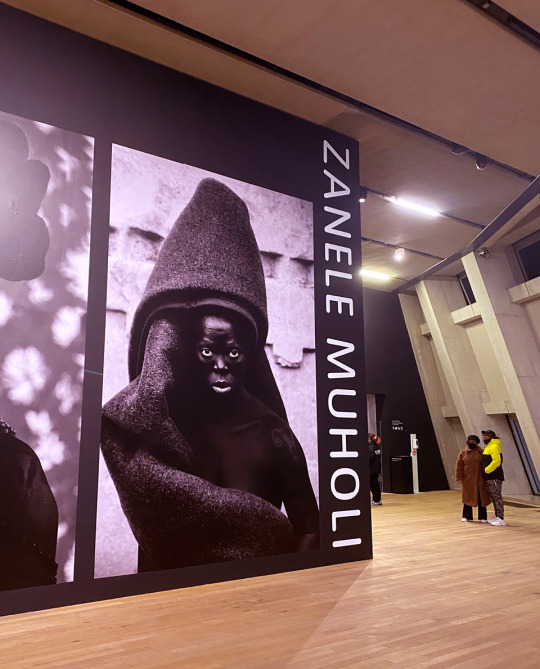
Walking into the Zanele Muholi exhibition at Tate Modern is like discovering another country.
In 2017 Muholi’s ongoing self-portrait series, Somnyama Ngonyama/Hail the Dark Lioness, was exhibited in London’s Autograph Gallery. In press reviews and posters on the tube that autumn, the images were unmissable and unmistakeable: stark black and white photographs of an impassive face crowned with Brillo pads or clothes pegs, festooned with vacuum cleaner hoses. At the time, Autograph wrote, the artist: “uses her body as a canvas to confront the politics of race and representation… Gazing defiantly at the camera, Muholi challenges the viewer’s perceptions while firmly asserting her cultural identity on her own terms: black, female, queer, African.”
Fast forward to 2020, and Tate Modern’s major Zanele Muholi exhibition. Visiting hours at the museum flicker in and out of existence as we navigate COVID lockdowns – now you can come! No, wait, sorry, you can’t. Try rebooking for a month’s time.
When I finally squeaked in, in early December, I expected more Dark Lionesses. I had a vague idea that Zanele Muholi was a bit like a South African Cindy Sherman.
I was wrong.
This exhibition shows the breadth of Muholi’s practice, of which the self-portraits are just one strand. The range and energy of the work is astounding. Especially given that in 2012 their studio was burgled and five years of work on hard drives was stolen.
Another mental adjustment: Muholi’s pronouns are they/them/theirs.
Born in Umlazi, South Africa, in 1972, at the height of Apartheid, Zanele’s father died when they were a baby and their mother, Bester, a domestic worker, had to leave her eight children for employment in a white household. Zanele was brought up by extended family. They started working as a hairdresser, then studied photography at Market Photo Workshop in Johannesburg, graduating in 2003, and going on to be awarded their MFA in Documentary Media from Ryerson University in Toronto in 2009.
On returning to South Africa they started to document the lives of the LGBTQI+ community.

Aftermath (2004)
The exhibition opens with a group of deceptively gentle images. In the first, Aftermath (2004), a torso is cropped from waist to knees, hands modestly clasped in front of Jockey shorts, a huge scar running down the person’s right leg almost like a piece of body art. In another, Ordeal (2003), hands wring out a cloth in an enamel basin of water placed on a floor. A third image shows a cropped, seated figure, again waist to thighs, hands folded in their lap, plastic hospital ties around their wrists. These pictures have a softness and beauty which completely belies the fact that their subjects are all survivors of sexual violence and “corrective rape”.
As the caption to the last picture, Hate crime survivor I, Case number (2004) explains, “Corrective rape is a term used to describe a hate crime in which a person is raped because of their perceived sexual orientation or gender identity. The intended consequence of such acts is to enforce heterosexuality and gender conformity.” This horrific practice is by no means unique to South Africa, but the term seems to have originated there – feminist activist Bernedette Muthien used it during an interview with Human Rights Watch in 2001 – and its effects on the community resonate throughout this exhibition.

Ordeal (2003)
They don’t, however, dominate. While the exhibition starts by showing the evils of intolerance of gender nonconformity, Muholi goes on to reclaim, elevate and celebrate that same nonconformity.
With Being (2006 – ongoing) we move on to photographs of naked bodies entwined – again tightly cropped, again soft black and white, but now without outside interference. They are sensual, personal, and owned. A series of portraits of two female lovers, Katlego Mashiloane and Nosipho Lavuta (2007) switches to colour and full figures. The couple sit entwined, laughing: they kiss, and bathe side by side standing in an enamel basin, in a warm, defiant echo of the scene in Ordeal (2003) across the room.

Katlego Mashiloane and Nosipho Lavuta, Ext.2, Lakeside, Johannesburg (2007)
The series Brave Beauties, started in 2014, is “a series of portraits of trans women, gender non-conforming and non-binary people. Many of them are also beauty pageant contestants.” The queer beauty pageant is many things: a celebration – and redefinition – of beauty, a declaration of independence by contestants, a challenge to “heteronormative and white supremacist cultures,” and an attempt, as Muholi puts it, “to change mind-sets in the communities [the contestants] live in, the same communities where they are most likely to be harassed or worse.”

Melissa Mbambo, Durban, South Beach (2017). Melissa Mbambo is a trans woman and beauty queen, Miss Gay South Africa 2017
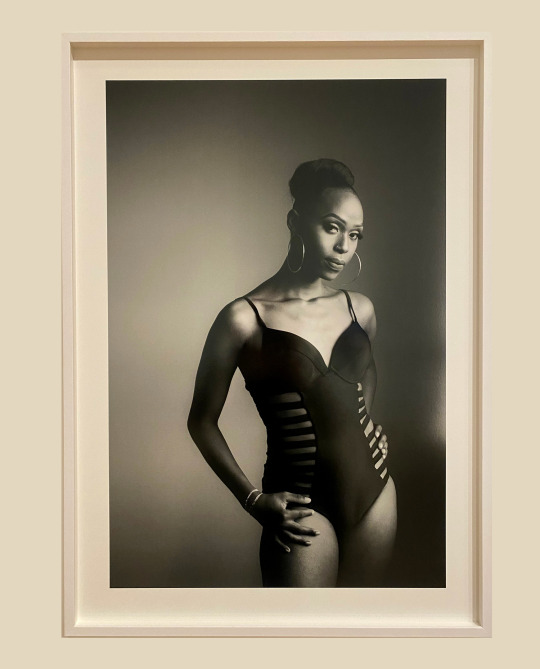
Roxy Msizi Dlamini, Parktown, Johannesburg (2018)

Akeelah Gwala, Durban (2020)
These portraits are made collaboratively, Muholi and the subjects choosing clothing, location and poses together. Some of them, like the picture of Roxy Msizi Dlamini (2018) have the quality of a classic glamorous studio shot. Others, like Akeeleh Gwala, Durban (2020), posing in a bikini against a scruffy brick wall in what seems to be a deserted brick alleyway, are a reminder of the vulnerability of the subject. Akeelah Gwala’s “Testimony” in the exhibition catalogue says: “I am 24 years old. I am a transgender woman. Growing up was very difficult because your parents think this is a boy… I was raped when I was 16 years old…” The rapist, a well-known pastor, threatened Akeelah’s family, forcing them out of their home. Akeelah refers to Muholi as “Sir Muholi” and says, “I have taken part in several beauty pageants. I perform because as a Brave Beauty, it is important to be visible and make others know about us and respect us as human beings.”

Miss Lesbian I-VII, Amsterdam (2009)
The theme of beauty pageants also features in the series of self-portraits Miss Lesbian I-VII, Amsterdam (2009), where Muholi casts themself as a beauty queen, an early identification with the wider community prefiguring Brave Beauties. The 2009 series brings together several of Muholi’s themes: the beauty pageant and the fashion/fashion magazine world; who gets to perform and who gets to watch; who gets to choose what beauty means? And, as an aside that may sound trivial but isn’t, kitchen utensils as headgear.
As the exhibition unfolds, we discover other projects. Muholi describes themselves as a visual activist, and they have a large network of collaborators, including the collective Inkanyiso (“Light” or “Illuminate” in isiZulu), a non-profit organisation focused on queer visual activism. We see images documenting marches and protests, weddings and funerals, and “After Tears” – gatherings held after burials to celebrate the life of the lost loved one.
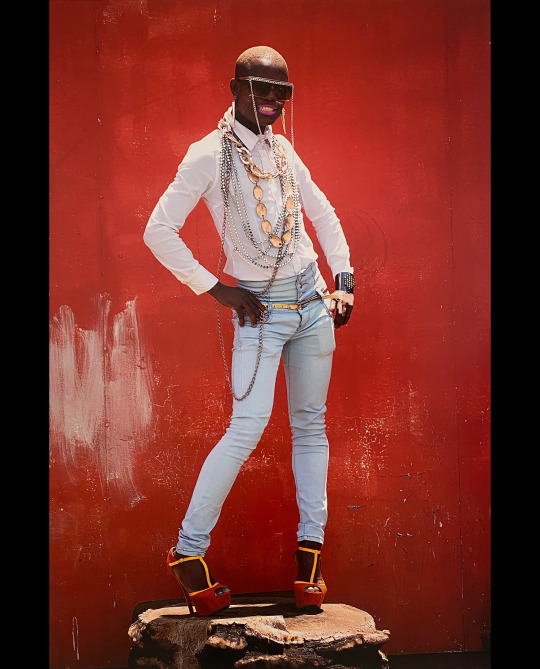
Nathi Dlamini at the After Tears of Muntu Masombuka’s funeral, KwaThema, Springs, Johannesburg (2014)
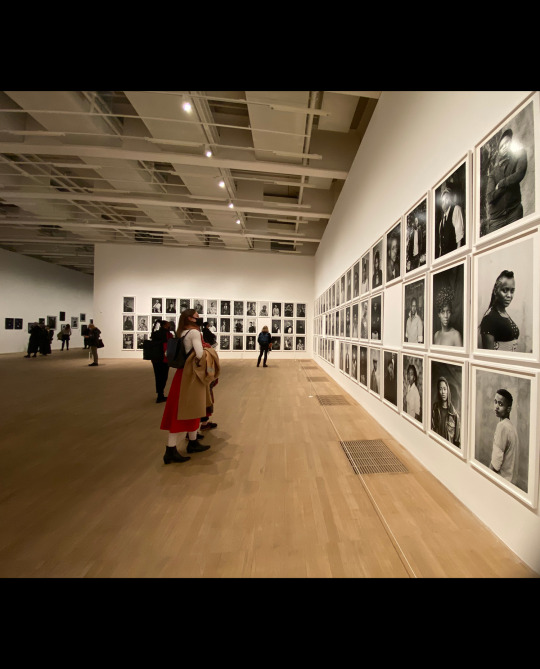
Death is a constant presence in Muholi’s community and work. The largest space in this exhibition is given to Faces and Phases (2006 – ongoing), a collection of portraits – 500, and counting. The images “celebrate, commemorate and archive the lives of Black lesbians, transgender and gender non-conforming individuals.” People appear more than once. Some spots on the walls are empty, marking a portrait yet to be taken or a participant no longer there. One wall is dedicated to those who have passed away.
Not only is this a powerful and moving project, it’s an extraordinarily beautiful set of pictures. As are the last works in the show, the series that started in 2012: Somnyama Ngonyama, Hail the Dark Lioness.
In this work, Muholi has darkened their skin and whitened their eyes, and composed the picture in the manner of a classical, perfectly-lit studio portrait, posing with found objects as “costume” – a footstool as a helmet, say. There is so much to unpick in these images – references to colonialism, Apartheid, to the politics of race and representation, to femininity and “women’s work”. Muholi presents us with a kaleidoscope of views of injustice, equal parts beautiful and brutal. The photographs were created in different parts of the world, at different times, combining what could almost be witty accessorising with intense cultural and political commentary.
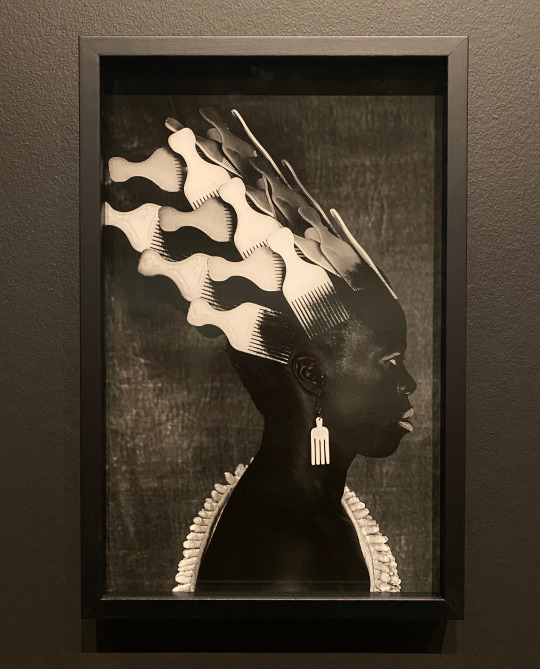
Quinso, The Sails, Durban (2019)
The intellectual focus of every picture is slightly different. Zamile, KwaThema (2016) shows Muholi draped in a striped blanket, as used in South African prisons during Apartheid. In Quinso, The Sails, Durban (2019) Muholi’s hair is adorned with silvery Afro combs, a symbol of African and African diaspora cultural pride. In Nolwazi II, Nuoro, Italy (2015) their hair is stuffed with pens – a reference to the “pencil test” whereby, under Apartheid, if a pencil pushed into a person’s hair fell out they were “classified as white”.

Nolwazi II, Nuoro, Italy (2015)
As mentioned above, Muholi calls themselves a visual activist rather than an artist – though galleries, like Tate Modern, might beg to disagree. Walking through this exhibition, I came away with the impression that their work is on the intersection of art and documentary photography – but also that everything is documentary: everything is story telling, and bearing witness, and the place where “documenting the community” and “expressing oneself as an artist” is continually blurred.
Maybe it’s not just like discovering a new country: maybe Zanele Muholi is showing us a whole new world.
Zanele Muholi is at Tate Modern until May 31, 2021
99 notes
·
View notes
Text
Toxic (Modern!Ivar x Reader)
A/N: Hi! I came up with an idea for this story as I re-watched season 4 and 5 of Vikings. It is also inspired by the music of 2WEI, so it’s kinda dark but I liked the idea in my head. I hope you guys like it as well. I’d love to hear your thoughts. This will be an ‘introduction’ to the story I want to create, so my apologies if it’s boring.
Thank you so much for reading! Sorry for the bad grammar, English is not my first language :-)
Warnings: Weapons, threat, Ivar, language
Words: 1314
Toxic II

gif is not mine
POV Ivar:
'Ivar, are you ready? Our driver is waiting outside?', Ubbe yelled up the stairs. We decided to go to this nightclub Helheim in the city to celebrate the victory against Ecbert and Aelle from England. Ecbert handed our father over to Aelle, who tortured and killed him. My brothers and I then paid them a visit to have a little conversation with them. Sadly they didn't survive this talk.
I took my crutch and went downstairs. My face still had some cuts and wounds from all the fights but it only made me look more dangerous.
'Brother, do you need some help?' Ubbe asked with a concerned look on his face. My left leg got bruised badly in a fight with one of Aelle's man. I looked up to face him. He always took care of me since I was little but when mother got killed his concerns kind of grew bigger.
'I'm fine', I scoffed. I wasn't fine at all but I didn't want them to know. They only would be much more worried than they already are. Besides that I wanted to get all of this shit from my mind.
As we arrived at the nightclub we walked up to the security man at the main entrance. We almost went to this club every weekend, so he already knew us. We walked by the queue. It was autumn, so the temperatures were kind of low. But all girls had short dresses on, probably hoping to get fucked tonight. The security man nodded at us and let us in. We immediately got escorted straight into the VIP area, which we basically owned. Not much time was wasted until all of the tables were covered with bottles of alcohol.
This is the club where I saw her for the first time. Freydis. The woman that broke my heart. The woman that betrayed me. She was the most beautiful thing I have ever seen. But she only got into my life because it was part of her job. She was a spy, send by Aelle so he could prepare himself to kill all of my family. I loved her with all my heart, that's why it probably hurt me more when I strangled her to death when I found out.
'Hey Ivar, I heard you were so furious in that fight last night', a pretty girl, that sat next to me, with a red satin dress that barely covered her ass drunkenly said in my ear. That happened all the time since Freydis disappeared magically. Every girl tried to get fucked by me. If they were pretty, I'd sometimes take them to a more quiet place, but only if I wanted to.
I sipped on my cup filled with expensive whiskey and Coke and ignored her even when she put her little soft hands on my leg and caressed it. Ubbe and Hvitserk were both busy making out with some girls. Probably friends of the one next to me. But I was not in the mood today.
As I put down my now empty cup I threw away the hand of that girl and looked up at the crowd. To have an eye on everything that was going on, I took my crutch and went to the railing of the VIP area. This area was above the dance floor, surrounded by a glass wall and under us was the DJ. My gaze went through all the drunk people dancing, making out and getting wasted. Now that we killed Ecbert and Aelle we had a lot of new enemies that wanted us dead, so I had to be even more attentive than before.
Suddenly there was a girl that caught my attention. Beautiful curves, long dark brown hair, a glittery black dress. As if she could feel my eyes wandering above her delicious curves she turned around and our eyes met immediately.
________
POV Y/N:
There he was. Locking eyes with me. The most dangerous man in Denmark and Europe. Ivar the Boneless. His hungry eyes went up and down my body while he was smirking and liking his bottom lip.
I slightly tilted my head and my eyes went to the stairs that led up to the VIP area and back to him. He nodded, as if he knew exactly what I wanted from him. I heard that Ivar liked pretty things so I knew exactly what I should wear to catch his attention, but I was still nervous. My hands were sweaty. Just his looks made me feel intimidated. My anxiety grew stronger as we stood there. Rumor has it that the last pretty thing he fell in love with once walked into their mansion and never came out again. At least not alive.
I slowly started walking in sync with him to the stairs never breaking the intense eye contact. As I was walking up the stairs when he told the bodyguards something I couldn't hear above the loud music and they immediately stepped aside, letting me in and closing the glass door behind me.
His brothers Ubbe and Hvitserk broke their hot make out session when they heard me stepping in, looking up in confusion because Ivar probably never let girls in by himself. It was always them who picked out their company.
Suddenly I felt someone behind me and then I felt a cold metal on my exposed lower back. A gun. My heart started racing. I guess this is what Ivar told the bodyguards. I wanted to move but my body was frozen.
Ivar came closer to me until only a little wall of air separated us. His mouth opened to a smirk. His eyes went to my lips.
'Don’t worry, this is just for our safety, Ivar said to me as he nodded to the man behind me. 'How can we help you?', he asked with his eyes on me again, watching my face closely. The girls already were guided out, giving us more privacy.
'My name is Y/N. Daughter of a loyal friend of Ecbert and Aelle.' I could see how they all tensed up when I said the names of the men they killed last night.
'I am not here to seek revenge on you. My family was brutally murdered as well as your father. By the same men.' Hvitserks eyes widened . 'My father didn’t want to sell me to Ecbert to marry Aethelwulf. A day later everyone in my village was dead. And I had to watch everything.’ Ubbe sat back in his seat.
'And what do you want from us now?’, Ivar hissed at me.
‘I know that you guys were sloppy last night. Ecbert's son Aethelwulf is still alive. And he is planning his own revenge.' Their faces went pale, not believing me.
Ivar's jaw clenched as his eyes went dark. 'How do we know you're telling the truth?'
The gun on my back clicked and I flinched. Don’t. Fuck. Up. Y/N. Ivar looked at me and I could see him lose his patience.
‘You don’t, but you can trust me. I want this son of a bitch dead just like you.’ As soon as I said that Ivar looked at me again, with a dark smirk on his face.
#vikings#ivar#ivar the boneless#ivar x reader#dark iver#fanfiction#vikings imagine#ivar imagine#ivar lothbrok#hvitserk#ubbe#lothbrok#ivar the boneless x reader#modern ivar
93 notes
·
View notes
Note
What are your thoughts on Earth One? I've read Batman and Wonder Woman but just started on Superman.
A disaster that has long since outlived its dubious usefulness, only surviving now on monstrous inertia and sheer fucking stubbornness.
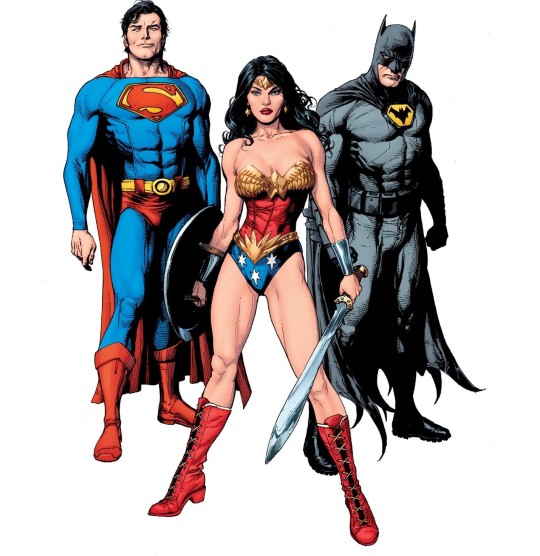
In fairness, it started as a great idea. Blockbuster-style ‘realistic’ origin stories of the biggest DC heroes in the OGN format and aimed at the bookstore market, with the biggest creators out there behind it? That’s genuinely inspired. The results however…Superman: Earth One and Batman: Earth One both manage the genuinely pretty incredible feats of being the worst story told of their title characters in almost 80 years. Both reasonable in concept - JMS had handled Marvel’s #1 boy to initial success and did some interesting work with the archetype in Supreme Power, and Johns/Frank on Batman would seem a surefire thing after their work on Action Comics. But there’s a gap between concept and execution here you could pilot an entire fleet of warships through.
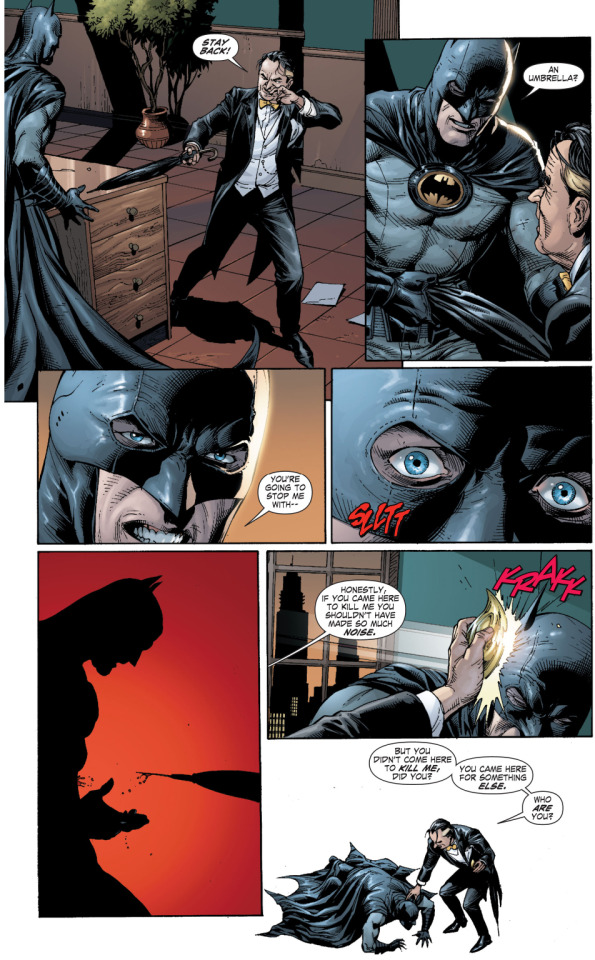
Batman’s an incompetent, banally vengeful, violent asshole who fails utterly at nearly every turn due to his utter lack of training or preparation, whose sole victory of substance is strangling a weaponized mentally ill man before being easily defeated by the dang Penguin, and being rescued by the use of guns. It admittedly tries to do something interesting with the idea of an urban vigilante who isn’t necessarily brilliant and unstoppable - he’s just got some incomplete military training and whatever gadgets he can cobble together - but one cheap “I’LL SAVE THIS CITY NO MATTER WHAT IT TAKES!” bit later and suddenly he’s for-real Batman even though he’s still a goddamn idiot. The sequel (checked out of the library) builds on this foundation to show he doesn’t have a clue about detective work, and the Riddler’s riddles are a distraction from a simple revenge scheme because hahaha, supervillain gimmicks are stupid. Also police brutality saves the day, which has sure aged well. Plus it’s all but directly Bruce’s fault his parents were killed. Throw some faux-deep monologuing on top about the rotting heart of the city and the meaning of life and death like a Snyder/Capullo joint gone septic, and you get a comic that manages to be both unpleasant and entirely boring. Looks nice though.
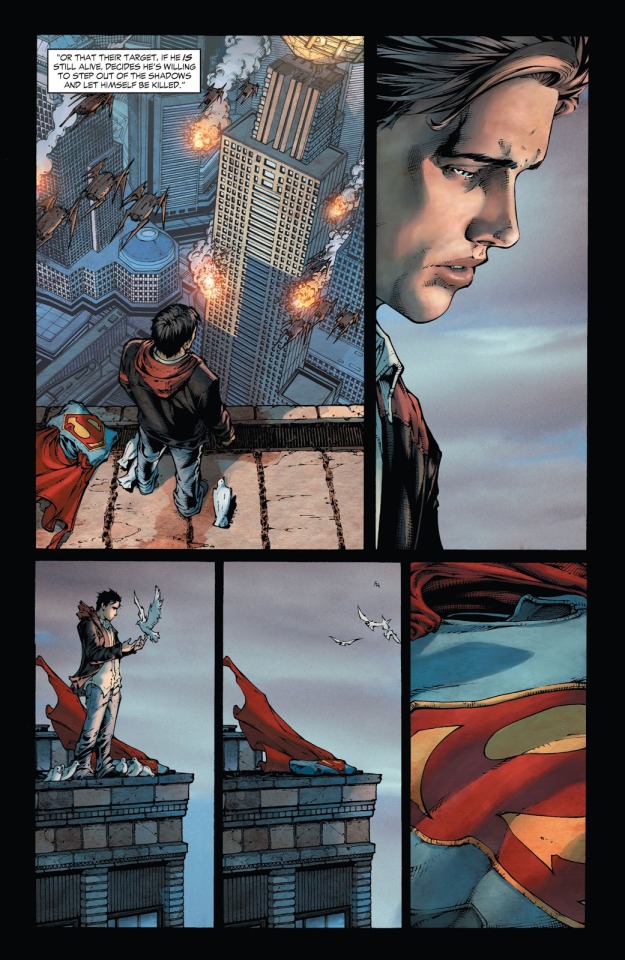
Superman, on the other hand, is the honest-to-god abomination of the pair. I’ve drained most of my poison on it over the years, through distance if nothing else, but this is one of the few comics out there whose existence sincerely makes me kind of angry. Not just because it’s a bad Superman story that catastrophically misses the point of the character, those are a dime a dozen - though yes, even aside from it being a Superman story, this is a painfully stock alien invasion/’embracing who you really are’ story we’ve seen a million times in a million better configurations. No, the thing that puts it over the top of the likes of, say, Superman II - which similarly has a Superman who’s kind of a total piece of shit - is that it is a story where he learns nothing from being a garbage person, and is rewarded for it.
There’s a scene of him at his father’s grave saying he’d rather use his powers to get rich than help people, and if not for the alien invasion, that’d be it. That’d be the end of the story, that’d be what this Clark Kent did with his life. Of course he spouts off some mealy-mouthed horseshit about how he’ll still find ways of helping people, but that’s a tad undermined that when the alien invasion does show and starts slaughtering people around the world en masse with the promise of exterminating everyone on Earth if he doesn’t fight back, he spends another 20 pages waffling until someone he likes is personally, directly threatened, making him not only a cowardly sack of shit unwilling to make the most clear-cut of moral choices, but also kind of a goddamn moron for not understanding right away that the space invaders raining laser death around the world are being serious. And then he sticks with being Superman not out of a realization that he must do what is right, or out of shame that so many died while he was afraid and selfish and refusing to waste his gifts ever again (a tack that handled right could have redeemed a lot of the earlier story), but because it turns out getting to use his gifts publicly as Superman is more fun and satisfying than being a football player. In the sequel (again, checked out of the library out of morbid curiosity) when he decides he must tackle the Real Issues, instead of overthrowing a dictatorship himself immediately and without casualties, he passes out AK-47′s to insurgents to arm a bloody revolution so that he can return the dictator’s earlier quip about how “he who has the guns makes the rules” before leaving him to die. The third at least managed to titanically up its game to crushing mediocrity - it almost reads like a new, marginally better writer trying to fix things up and manage a soft reboot - but that hardly balances the scales. As usual, I’ll default to Colin Smith’s fantastic set of articles comparing it ethically and storytelling-wise to All-Star Superman, but this is one of maybe two or so pieces of pop media out there where I can’t find enjoyment of it anything other than objectively wrong (the other being Thor: The Dark World, though that was merely really really overwhelmingly shitty).
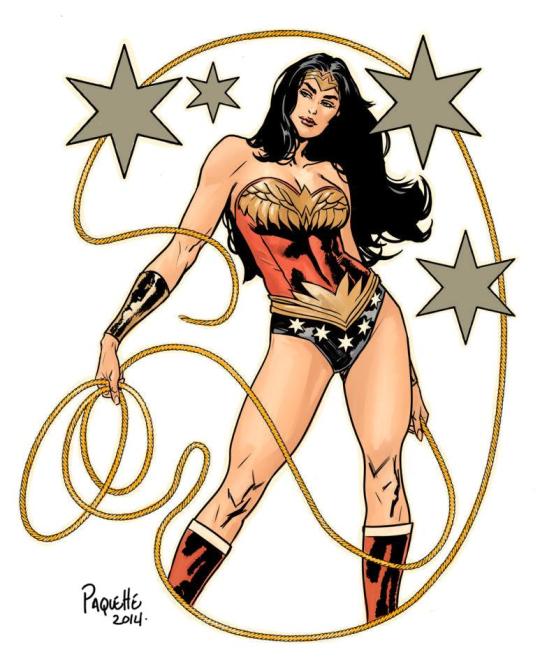
The Titans book…existed, I guess, and didn’t pull off much more than that. Morrison/Paquette/Fairbairn’s Wonder Woman was interesting if nothing else, and it did a better job of building up Paradise Island visually as a high-concept super-feminist-fantasy-wonderland than anything else I’ve ever seen, but it was critically flawed. The characterization for Diana is pretty paper-thin, and as a feminist text it’s if nothing else yet another argument that Morrison probably shouldn’t be trying to write about contemporary social issues if he essentially refuses to use the internet - Elle Collins’ and Kelly Kanayama’s pieces on it go into its failings far better than I ever could. It was a fascinating failure at least as opposed to the rest, I’m genuinely curious where further volumes might go, but I’d consider it Morrison’s most significant failure as a superhero writer so far of the 21st century. An experiment in seeing if he could write Wonder Woman, rather than something he did out of sincere interest.
Earth One outlived its purpose once the New 52 hit, but it sold just well enough that DC couldn’t justify throwing it aside, so it still goes on. Superman may be done now that JMS has left comics (as should be Flash: Earth One, which I actually consider a shame given it apparently would have come out close to Morrison’s Multiversity Too: The Flash, which would’ve been a gut-buster of a contrast) unless someone else comes on to continue it, and Aquaman: Earth One may have fallen by the wayside, but Johns and Morrison have both confirmed there’s going to be more Batman and Wonder Woman, so at this point I don’t think it’s going to go away until we at least see Justice League: Earth One, presumably Chuck Austen’s triumphant return to DC. In spite of that though I maintain the experiment has utterly failed, the greatest testament to that being that when Morrison’s described Earth 1 in The Multiversity Guidebook he noted that the Earth was ‘in flux’, thereby inserting an escape hatch - essentially admitting that that Earth sucks so bad that you shouldn’t have to believe it actually exists in the Multiverse if you don’t want to.
EDIT: jonsei93 said: Damn, it’s kinda sad that THIS Superman gets to wear the classic costume instead of the main one. Because E1 Superman really doesn’t deserve to wear it, let alone touch it! (Yeah, I read a little of Superman Earth One, too and….yeah, I didn’t really bother acknowledging those books after that)
There are definitely people out there who considered Earth One to be the proper modern reinvention of the character rather than the New 52 guy, I’m pretty sure entirely based on that suit. Knowing this makes me feel bad.
#Superman: Earth One#Superman#Batman: Earth One#Batman#Wonder Woman: Earth One#Wonder Woman#Teen Titans: Earth One#Teen Titans#DC Comics#J. Michael Straczynski#Shane Davis#Geoff Johns#Gary Frank#Grant Morrison#Yanick Paquette#Nathan Fairbairn#Opinion
41 notes
·
View notes
Link
Artist: Paulo Nazareth
Venue: Mendes Wood DM, Brussels
Exhibition Title: [A] LA FLEUR DE LA PEAU
Date: April 24 – June 1, 2019
Click here to view slideshow
Paulo Nazareth, Iroko de Bom Jesus, 2017, video performance, 4:17 (excerpt)
Full gallery of images, videos, press release, and link available after the jump.
Images:
Videos:
Paulo Nazareth, Iroko de Bom Jesus, 2017, video performance, 4:17 (excerpt)
Paulo Nazareth, Iroko de Bom Jesus, 2017, video performance, 4:17 (excerpt)
Images courtesy of Mendes Wood DM, Brussels
Press Release:
On my mother’s saints: colonial cartographies and urgent epistemologies
Throughout the journey of Paulo Nazareth’s [A] LA FLEUR DE LA PEAU it is impossible not to evoke the abyss metaphor suggested by Martiniquais writer Édouard Glissant in Poetics of Relations. The image of the ship operates as a place of exile for Black bodies on the way to the unknown. The first abyss is experienced when entering the ship. The second is the sea crossing. Great Kalunga. The third abyss is the inverted image of glimpses of memory where new roots are laid through networks of learning. Rhizome. The shared knowledge of an experience of meandering exile, where every identity is extended through a relationship with the Other. Paulo Sérgio da Silva. Paulo da Silva. Sérgio da Silva. Ser da Silva. Paulo Nazareth. Nazareth Cassiano de Jesus. The Mother of his Mother. Ana Gonçalves da Silva. The Mother of his Sister. Ana Maria da Silva. The Grandmother, the Mother, The Sister and Motherhood. His Égun or Égúngún, for the Yorùbá people. Or, even, his Marét, for the Boruns, Indigenous people from Vale do Rio Doce. The ancestral spirit. Nazareth also becomes art materiality and immateriality. Transit between worlds. Transit between times. The act of traveling and handing out pamphlets reasserts the place of aesthetical conduct: expanded performance, generational event. Selling homemade soap made with chicken fat, sugar, lime, avocado, urucum. Distributing pamphlets-cards-leaflets for dentists, healthcare plans, Candomblé houses in Belo Horizonte (Minas Gerais). All work activities that the artist has performed in the past.
The journey introduces a self-ethnographic dimension where both autobiography and ethnography force us into a relationship of pertaining symmetry between Same versus the Other, Subjectivity versus Alterity, Individual versus Collective, Subject versus Object. Consequently, this generational event is mirrored in the act of walking performed by his mother Ana and sister Ana who go on a pilgrimage via emblematic routes as a metaphor for Mother Africa and the Diaspora. The route covers places such as the Musée de l’Homme (France) and the maximum-security prisons La Santé (France) and Saint-Gilles (Belgium). A ritual performance that combines aspects of the sacred and the profane when his mother Ana prays for the afflicted souls of genocide victims. The act condemns the colonial violence imposed by Belgian King Leopold II to secure the appropriation of the Congo. To the same extent, the pamphlets provide a sort of aesthetics of emergency in the artist’s own words: to burst open the headstone and cut the king’s throat with an arrow soaked in GOLDEN FROG poison. —– with an arrow from the Pre-Columbian people EMBERA::: kill the king before he arrives in CONGO.
Within this performance context, we have the series Santos de Minha Mãe [My Mother’s Saints] made-up of food products inside resin blocks that feature the names of saints that safeguard requests for family protection and amulets to protect the body against danger. Nazareth also reclaims different forms of resistance used by enslaved people, such as Black brotherhoods and sisterhoods. Or even the Christianity of traditional street events such as Folias de Reis, Guarda de Congado and Moçambique in Minas Gerais. It refers both to a history of agricultural technologies linked to a colonial logic of commodities and the commercialization of faith. His visual discourse presents art collecting as a critical practice. The processes of ordering objects evoke the collections of cabinets of curiosities that later became ethnographic museums, tangentially to values of aesthetics, art and science.
In the field of anthropology, the invention of photography anticipated its scientific use in studies on evolution, anthropometry and material culture. This led to the selection, classification and hierarchy of the cultural Other. Here we can cite the five daguerreotypes of a Borun woman and young man captured by E. Thiesson in Paris (1844), which belong to the Musée de l’Homme. The records of these dehumanised bodies that were exhibited under a mechanical gaze are confronted by his mother’s human gaze. This is not only Ana’s gaze; it is combined with Nazareth’s, re-signifying the place of science, annihilation and slavery in the re-elaboration of the subjectivity of these two people photographed, conjuring up a family history. The meaning of the exhibition becomes polysemic when connected to the voids and confrontations of the everyday experiences of hegemonized bodies.
The place of technology as politics of destruction and restitution of narratives is challenged in another series that uses black and white photography and printing on cotton paper to show images collected on the Internet. This materiality refers to agricultural technologies and social division of labour, as well as to cotton trading routes within a colonial history that entailed the transplantation of science from African people to the colonies during the Diaspora. The souls of anonymous people are captured at the same time these images are diluted by the fading of a collective social memory. It is a sort of shadow projecting an absence. Yet, it is one that paradoxically reveals a presence that is anterior to Ana and Nazareth. The photographic records are disrupted with white circles made of efun (a type of chalk used in Afro-Brazilian rituals). These circles are used in liturgical activities and refer to the re-establishment of balance by reclaiming a new voice for these hegemonized narratives.
In another work, Nazareth examines the political technology of bodies when he approaches the issue of the imprisonment of Black men in penal institutions. They are the drivers of the exercise of violence as a programmed and selective erasure of these selves. These relations appear in placards with the names of maximum-security prisons contrasting with the relationship between colonial powers and their colonies: La Santé (France), Saint-Gilles (Belgium) and Kabare (Congo). Most importantly, the African prison is not a native institution, but a colonial remnant of body control. Crime becomes a tradable Black product. The experience of walking as an aesthetic form also appears in the performance (Mendes Wood DM Brussels, April 24th 2019) where the anonymous bodies of non-white immigrants perforate bags of flour and sweep the white powder into circles. The object of art is intertwined into the everyday life in the brutality of the white circle. Concrete geometric order. The daily ritual manifested in contemporary art. White circles associated to efun as a liturgy that re-organises a history interwoven with colonial violence and trauma.
Nazareth’s artistic propositions create a journey where aesthetic acts produce urgent epistemologies to invest against the marks of colonial cartographies. This appears in the duality of the circle that evokes the mathematical thought of Ancient African and 8th century Islamic geometry. The circle of African tradition contrasted to the rationality of Western art’s concrete art circle. Modernism. Post-Modernism. The performance and labour gesture of forming the circle. The political context of neoliberal capitalism that perpetuates inequalities.
The tensioning of these cartographies and the re-affirmation of community voices are re-elaborated in the dismantling of colonial traps through the use of technologies to control and intervene on individuals by articulating the planned annihilation of collectivity.
– Janaina Barros Silva Viana
Visual artist, researcher and art critic, focusing on Brazilian contemporary art produced by Black artists.
Paulo Nazareth (Governador Valadares, 1977) lives and works throughout the world. His most recent exhibitions include Paulo Nazareth, ICA Miami, Miami (2019); Faca Cega, Museu de Arte da Pampulha, Belo Horizonte (2018); Old Hope, Mendes Wood DM, São Paulo (2017), Genocide in Americas, Meyer Riegger Gallery, Berlin (2015), Journal, Institute for Contemporary Arts, London (2014), Premium Bananas, MASP, Museum of Art São Paulo (2013).
Recent group exhibitions include How to talk with birds, trees, fish, shells, snakes, bulls and lions, Staatliche Museen zu Berlin, Berlin (2018); EXTREME. NOMADS, MMK Museum für Moderne Kunst, Frankfurt am Main (2018); The Lotus in Spite of the Swamp, Prospect.4 Triennial, New Orleans (2017); Field Gate, Remai Modern, Sasktoon (2017); Soft Power. Arte Brasil, Kunsthal KAdE, Amersfoort (2016); Much wider than a line, SITE Santa Fe, Santa Fe (2016); New Shamans/Novos Xamãs: Brazilian Artists, Rubell Family Collection, Miami (2016);Indigenous Voices, Latin American Pavilion 56th Venice Biennale, Venice (2015); The Encyclopedic Palace, 55th Venice Biennale, Venice (2013); Museum as Hub: Walking Drifting Dragging, New Museum, New York (2013).
Link: Paulo Nazareth at Mendes Wood DM
Contemporary Art Daily is produced by Contemporary Art Group, a not-for-profit organization. We rely on our audience to help fund the publication of exhibitions that show up in this RSS feed. Please consider supporting us by making a donation today.
from Contemporary Art Daily http://bit.ly/2HHFaTa
0 notes
Text
'The Tempest' as a Postcolonial Text
The Tempest as a Postcolonial Text
According to the Oxford English Dictionary (OED), the word ‘colonialism’ emerges out of the Roman ‘colonia’ which translates to ‘farm’ or ‘settlement’. It was a reference to Romans who settled down in other lands while retaining their citizenship. The OED definition of colonialism as Ania Loomba points out in her book Colonialism/Postcolonialism, does not make any reference to the natives, people who might have been living in places where colonies were established. This essay will consider The Tempest in the light of postcolonialism using Loomba’s theories and the relationship between the natives of the island and Prospero, Stephano and Trinculo.
William Shakespeare draws inspiration for The Tempest from William Strachey’s account of a ship that ran into a storm. It was on its way to Jamestown, Virginia. The passengers surprisingly were safe and it resulted in the first colony which was set up in 1607. The play was written in 1611. Loomba states that Shakespeare adds a major component to the play, which was absent in the account. This is the idea of the island being inhabited prior to Prospero’s arrival. It renders the play into an allegory of a colonial encounter, more than a romance. In order for Prospero to sustain his power, there was a certain “re-forming” and “un-forming” (Loomba, 8) that had to be done. It includes practices such as “trade, plunder, negotiation, warfare, genocide, enslavement and rebellions.” (Loomba, 8).
These are some of the factors that distinguish between colonialism in the Genghis Khan era and the modern colonialism. Modern colonialism made sure that there was a link between the economy of the colonized lands and the colonizers’ land. There was a flow of human and natural resources between the colonized and colonial countries. This was in the form of slaves and raw materials. The profits were obtained by the colonial powers. In The Tempest, Prospero uses Ariel and Caliban for their services claiming that he rescued one and raised the other. Ariel and Caliban are not only used for labor, but also are “educated” with the European ideology. Having established the colonized as the ‘other’, the Europeans felt the need to educate what they thought were savages. This idea is talked about by Edward Said in Orientalism where he notes how Arabs were seen as exotic, backward, uncivilized and dangerous. This idea is carried out in the case of Caliban who is described in an animal-like fashion. Prospero accuses him of attempting to rape Miranda in the past, a reason he uses to impose control on him.
Similarly, the idea of the cannibal was used by Columbus and by Spanish colonists later on to justify their brutal practices. Loomba talks about a Martin Frobisher who used an Eskimo for display in England. This idea resonates in The Tempest where Trinculo thinks about the money he could earn by doing the same with Caliban. He muses how people “will lay out ten (coins) to see a dead Indian” (1, ii, 32-33). This is a stereotype. Sander Gilman says that stereotypes promote an “artificial sense of difference between ‘self’ and ‘other’” (Loomba, 55). Prospero, Trinculo and Stephano clearly use this technique to degrade the position of Caliban.
On the other hand, the colonized people, as mentioned earlier with reference to Orientalism, were considered exotic, yet inferior, while the latter considered the former as enviable, and corrupt. This instance can be seen in The Tempest when Prospero refers to Ariel as “delicate” (4, i, 49) and as a “fine apparition” (1, ii, 319) but also reminds Ariel that he is a “malignant thing’ (1, ii, 259). Caliban views Prospero as powerful and desires to overthrow him. This highlights the ambivalent relationship that the two parties share. The idea of the colonized being “exotic” is carried out across the geography of the colonized land. This results in the colonizer using the colonized as a medium to access resources and ‘secrets’ of the land and culture. It shows how the colonizer considers it necessary to tame not only the natives, but also the land itself. Another factor used to create the binary of the European and non-European is the language.
Peter Hulme refers to two words which were derived from Native American languages. The words ‘cannibal’ and ‘hurricane’ were used to widen the gap between the colonizer and the colonized. Hurricane was referred to as a tempest, unique to the Caribbean and suggested the supposed violence and savage condition of the place. Similarly, cannibalism was not merely a synonym for ‘anthropophagi’ (savages who eat their own kind). Cannibalism was a marker for the threat the savages posed against Europeans, as Loomba points out. As a natural phenomenon and a cultural practice, the terms designated anything that was situated outside Europe. ‘Canis’ is a Latin word referring to dog, and the view was that the people of the Caribbean treated their victims in a ferocious, predatory manner. It is no surprise that Caliban is an anagram for cannibal (negating the ‘n’) and also explains why Prospero uses dogs to attack the rebels as Hulme points out. Cannibalism was also used as a pretext to justify the taking over the American lands.
Apart from the image of the cannibal, the image of the colonized as a dark-skinned rapist is established. Prior to this, the colonizers were seen as the rapists who plundered countries. The narrative changed with time. Caliban, too is alleged of an attempt to rape Miranda. The notion of the savage rapist, as Loomba argues, “…deflects the violence of the colonial encounter from the colonizer to the colonized” (Loomba, 70). Jenny Sharpe in her book Allegories of Empire: The Figure of Women in the Colonial Text demonstrates how Indians were seen as mild and meek until the 1857 revolt. Following this, the ‘mild Hindoo’ became a sexual predator who raped British women. Sharpe suggests that the rebellion left the British “without a script on which they could rely” (Sharpe, 67). Caliban is the more rebellious of the slaves. Ariel is mild and soft spoken. Caliban’s rebelliousness ears him the place of a savage rapist.
This brings up the need for civilizing the ‘savage’. The phrase ‘white man’s burden’ was used as an ideology to denote the duty of the white colonizers to educate the colonized with western ideologies in order to ‘help them out’. In the play, Prospero educates Caliban and teaches him the former’s language. Caliban exclaims “You taught me language, and my profit on’t / Is I know how to curse. The red plague rid you / For learning me your language!” (1, ii, 365-367). It is similar to the ‘subaltern’, a term coined by Antonio Gramsci to identify people excluded from society’s established institutions. Gayathri Spivak notes how the subaltern, in order to be heard, must adopt the Western language. Caliban, similarly, uses Prospero’s language to insult him and express his discontentment. Through his language, the colonizer creates narratives to explain the local history of the colonized land. These narratives overwrite and silence the local narratives. Prospero repeatedly tells Caliban and Ariel about how he rescued them. The story of Caliban’s childhood and Ariel’s imprisonment is continually repeated by Prospero. Joseph Goebbels says “If you tell a lie big enough and keep repeating it, people will eventually come to believe it.” So the questions one needs to consider while looking at The Tempest as a colonial text are – Did Caliban really try to rape Miranda, or could it possibly be a narrative used to oppress him, and one also needs to consider how much of the native perspective is highlighted. However, one does see Caliban claiming his authority over the island, as he is the true inhabitant and considers Prospero as an outsider. It is visible in the lines where Caliban says “This island’s mine, by Sycorax my mother, / Which thou takest from me.” (1, ii, 333-334). This leads to the representations of the play as a depiction of colonial oppression. In the 1960s and 1970s, de-colonization movements began in Africa, Caribbean and Latin America. The anti-colonial writers challenged the notion of Prospero’s ‘art’ being considered as a part of the civil world, while Sycorax’s natural black magic is considered evil. Writers began defending Caliban’s right to the island. The lines quoted at the end of the preceding paragraph highlights this. Aimé Césaire, a black writer from Martinique rewrote the play to celebrate Caliban’s verbal attacks on Prospero and questions his claim to the island. In Jonathan Miller’s 1988 production of The Tempest, Prospero is a white colonizer and Caliban is a black slave. In David Thacker’s 1995 production, Ariel was played by a woman with face paint of a Native American Indian. Hence it is evident how the text was interpreted from an anti-colonial point of view, recognizing the postcolonial ideologies and representations in the original text.
On a similar note, Joanne Drayton in her article talks about how chess is seen as a metaphor for the “postcolonial relationship between Maori (indigenous Polynesian people of New Zealand) and Pakeha (New Zealander of European descent) in Aotearoa New Zealand.” (Drayton, Researchgate). It brings about questions of diaspora and the idea of the carrying of culture, since chess has been attributed to Viking culture. In the play, one finds Ferdinand and Miranda playing a game of chess. This symbolizes how Prospero’s every move is calculated and used to manipulate the rest of the characters in in the play.
With regard to a counter-view when studying the play as a postcolonial text, Meredith Anne Skura suggests that the parallels to colonial discourse are unintentional and cannot be taken seriously. She claims that the exploitation of people has been dealt with in several other plays of Shakespeare, and that it was too early for the colonial ideology to set in, since the play was written merely four years after the setting up of a colony in Virginia. She further explains how the characters can be seen as manifestations of human personalities. Caliban could be a representation of Prospero’s evil side. The latter acknowledges this at the end of the play when he says “This thing of darkness I / Acknowledge mine.’ (5, i, 277-278). Skura makes several important points including the fact that Caliban is not a representation of the cannibal, since he does not eat meat, instead “confining himself more delicately to roots, berries and an occasional fish” (Skura, 59).
However, as pointed out by Loomba, the fact that the playwright added the presence of inhabitants, slavery, narratives, and a subjugation and exploitation of the inhabitants renders the play as a portrayal of colonialism, whether or not the writer intended to represent it in that light. In popular culture, one sees colonial ideas and attitudes, for instance, in the Tintin comics, the artist depicts gypsies, native Americans, and Indians in a racist and stereotypical light, and the same can be said about the film Indiana Jones and the Temple of Doom. Professor Yvette Rosser comments on how the film is a racist portrayal of Indians. Kayleigh Donaldson in her article Problematic Faves: Indiana Jones talks about the blatant racist outlook on Indians and South Asians, as the Hindus are represented as blood drinking, demon worshiping savages with odd and revolting food habits. Hadley Freeman highlights the racism in the movie in her article Blacking up, wacky Asians and the Libyans: the worst of 80s movie racism, where she makes references to the racist representations of Blacks and Asians. Hadley Freeman hardly finishes pointing at how the films have shown to be racist, when the stark irony is revealed, when she exclaims “Ha ha ha, Asian people are GROSS” (Freeman, The Guardian) .This goes on to show how racism and stereotypical notions along coupled with the white man’s superior attitude still permeate the society today, as a result of colonization.
To conclude, The Tempest has been considered from a postcolonial critical viewpoint, since it embodies the attitudes, practices and ideologies of the European colonizer. It has also been observed how colonization has led to racism and stereotypes that still exist in today’s society.
WORKS CITED:
Books
Loomba, Ania. (2005). Colonialism/Postcolonialism. Routledge, 2005.
Shakespeare, William, and John Crowther. The Tempest. Sparknotes, 2003.
Speaight, Robert. Shakespeare On The Stage. Little, Brown, 1973.
Sharpe, Jenny. Allegories Of Empire. University Of Minnesota Press, 1993.
Gilman, Sander. Difference and Pathology: Stereotypes of Sexuality, Race and Madness. Cornell University Press, 1985.
Websites
Donaldson, Kayleigh. "Problematic Faves: Indiana Jones". SYFY WIRE, 2019, https://www.syfy.com/syfywire/problematic-faves-indiana-jones. Accessed 2 Apr 2019.
Freeman, Hadley. "Blacking Up, Wacky Asians And The Libyans: The Worst Of 80S Movie Racism". The Guardian, 2019, https://www.theguardian.com/film/2015/may/10/wacky-asians-blacking-up-and-the-libyans-the-worst-of-80s-movie-racism. Accessed 2 Apr 2019.
"Joseph Goebbels On The "Big Lie"". Org, 2019, https://www.jewishvirtuallibrary.org/joseph-goebbels-on-the-quot-big-lie-quot. Accessed 2 Apr 2019.
"Production History | The Tempest | Royal Shakespeare Company". Org.Uk, 2019, https://www.rsc.org.uk/the-tempest/past-productions/production-history. Accessed 2 Apr 2019.
Anne Skura, Meredith. Discourse And The Individual: The Case Of Colonialism In "The Tempest". 1989, https://www.jstor.org/stable/2870753. Accessed 2 Apr 2019.
#shakespeare#postcolonialism#Literature#article#Theory#postcolonialtheory#art#Theatre#thetempest#play#drama
1 note
·
View note